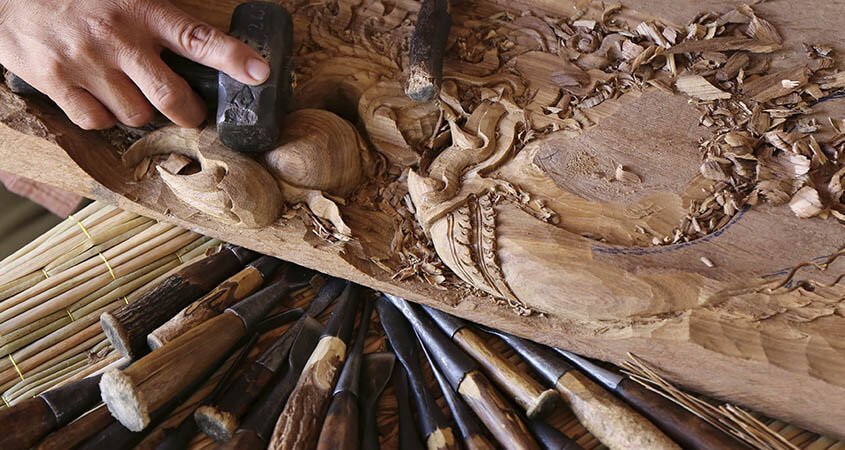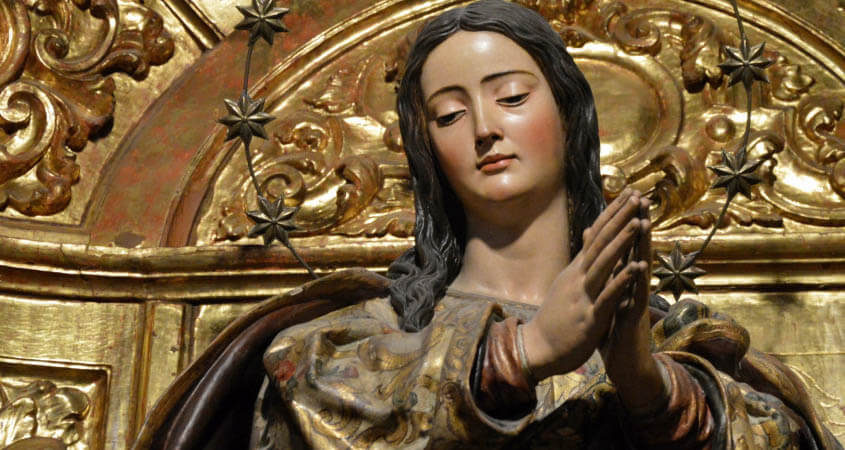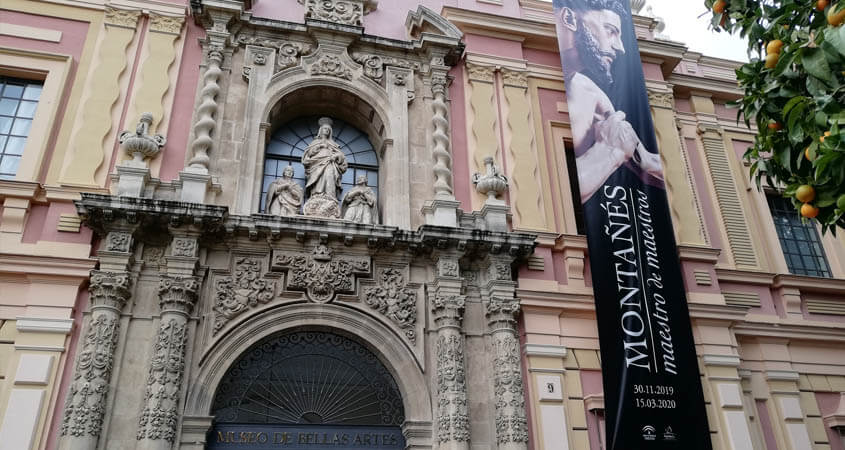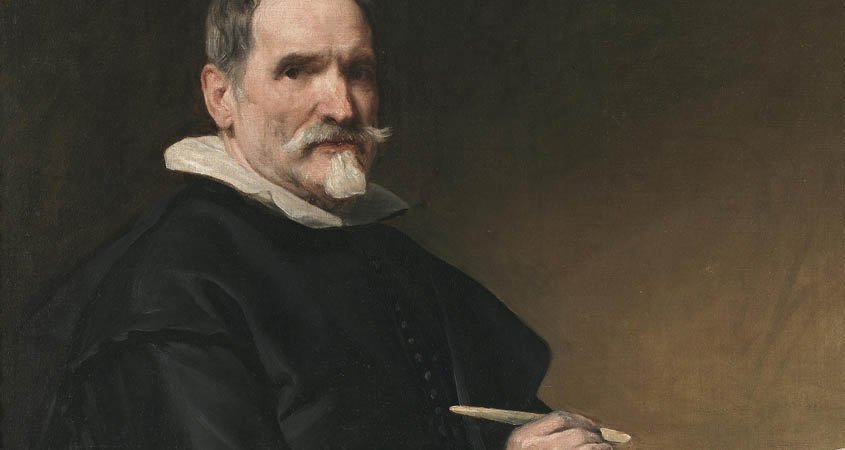Baroque sculpture in the Fine Arts Museum of Seville (November 2019-March 2020)
The subtitle of this exhibition is “Teacher of Teachers” and this is true, since we must not forget that his art was inherited by sculptors such as Juan de Mesa or Francisco Antonio Ruiz Gijón, authors of the Christs of the Gran Poder or el Cachorro who can be contemplated in the famous processions of Holy Week in Seville.
But our protagonist of today was the called already in his time “God of the Wood”. Juan Martinez Montañés was born in a town near Jaén in 1568. At that time the most important artistic center in the south of the Iberian Peninsula was Seville, so Juan Martínez went to the capital of Andalusia to work on his sculptures. Here he could have numerous commissions from the convents and churches that flooded the city. His religious sculptures are splendid examples of naturalism and realism. The San Juan Evangelista, San Juan Bautista, Immaculate Concepcion, Christs and Children Jesus even today, 400 years later, surprise us for their quality and mastery, it does not surprise us therefore that in their time he was considered the “God of the Wood”.
Now we have a magnificent opportunity to see 57 of his best works gathered in an exhibition of the Museum of Fine Arts in Seville.
Why the sculptures where made in wood

In Italy the sculptures were made mostly in marble, this was due to the abundance of this material in that country. The best sculptures by Michelangelo or Bernini were made in a beautiful white marble.
However, in the Iberian Peninsula, it was originally worked in terracotta or baked clay, in this material was the San Jerónimo de Pietro Torrigiano of the Museum of Fine Arts of Seville, an Italian sculptor, colleague of Michelangelo, who introduced naturalism in Spain but using a local material like terracotta.
Gradually this was passed to the wood, which allowed sculpting with greater detail and was a stronger material, not as heavy as marble, of a more moderate weight and which allowed these sculptures to be carried in procession. Those religious processions that began to become popular in these lands.
Technics for painting the sculptures whith gold
The wooden sculptures were “estofado” and polychrome. “Estofado” is a very difficult technique that consists of applying gold leaf (also silver or copper leaf) to the wood, some sheets of metal that print this golden hue on the surfaces on which it is placed. Then, with different pigments these sheets are covered, and finally by scraping these last layers, drawings are made and colored (polychrome) exposing the underlying gold. As you can imagine it is a very expensive procedure but with a brilliant result, great color and artistic richness.
Normally the sculptor did not deal with this stage but it was carried out by another artist. Often the sculptures of Montañés were polychromed by Francisco Pacheco, painter, writer and teacher, best known for being Diego Velázquez’s father-in-law.
What are the best sculptures by Martínez Montañés
His most important works in Andalusian baroque sculpture can be seen in the Fine Arts museum exhibition.
The Christ of Clemency was always considered one of his greatest works. He did it for the Priest Vazquez de Leca, a rich religious who ordered him to have it for his personal devotion. Later on this sculpture would be exposed in the Cathedral of Seville. This work of 1.80 meters, of surprisingly exact details that show us the muscles and veins of a Crucified Christ, was a role model for all the sculptors of later generations.

Do not forget your other key work, the so-called La Cieguecita, “the Little Blind”. This is a sculpture that represents the Immaculate Conception, 1.64 m high. His eyes with a low and modest look that give an impression of being blind are the origin of his nickname. This sculpture was quickly famous for its great beauty and delicacy. Its serene face and harmonious proportions make it one of the most accomplished works of its author. The Immaculate was a very repeated theme in both painting and sculpture, accompanied by its usual elements such as the crown of twelve stars, the blue mantle, the tread on the crescent moon or the heads of angels at its feet that propel it towards the heaven.
But Montañés also worked for the most influential Sevillian monasteries of the time. For San Isidoro del Campo, a Hieronymite monastery on the outskirts of Seville made a splendid altarpiece in which are the praying sculptures of Guzmán el Bueno and his wife Maria Alonso Coronel, founders of the medieval monastery. Also San Juan Evangelista and a surprisingly realistic San Jerónimo Penitente.
The Child Jesus of the church of the Holy Sacrament, the Christ of Passion or the San Cristobal from the Church of the Saviour are also among his masterpieces.
Diego Velázquez and Juan Martínez Montañés, contemporary artists

Among the contemporary artists of the sculptor were the writer Cervantes and the painters Rubens or Velazquez himself.
We are lucky to have a portrait of Martinez Montañés made by the latter. Diego Velazquez, somewhat younger than the sculptor, worked in Madrid for King Felipe IV but the fact of being from the same city, Seville, and that they were both artists and frequented the same circles, led him to make a portrait of the “god of wood” in 1635. In that year the sculptor was called to the Court to make a bust of the king who wanted to send to Florence. That bust, that can be see in the picture, would be the model for the statue of Philip IV of Spain that adorns the Square of Oriente in Madrid.
Black death of 1649

The catastrophic plague epidemic of Black death this year took the lives of almost half of the Sevillians and among them that of Montañes, who was already 81 years old.
In his long life he left us amazing sculptures of the highest quality. Luckily we can see them all together today in this interesting exhibition that has its doors open until March 15, 2020.
Do not miss it!
